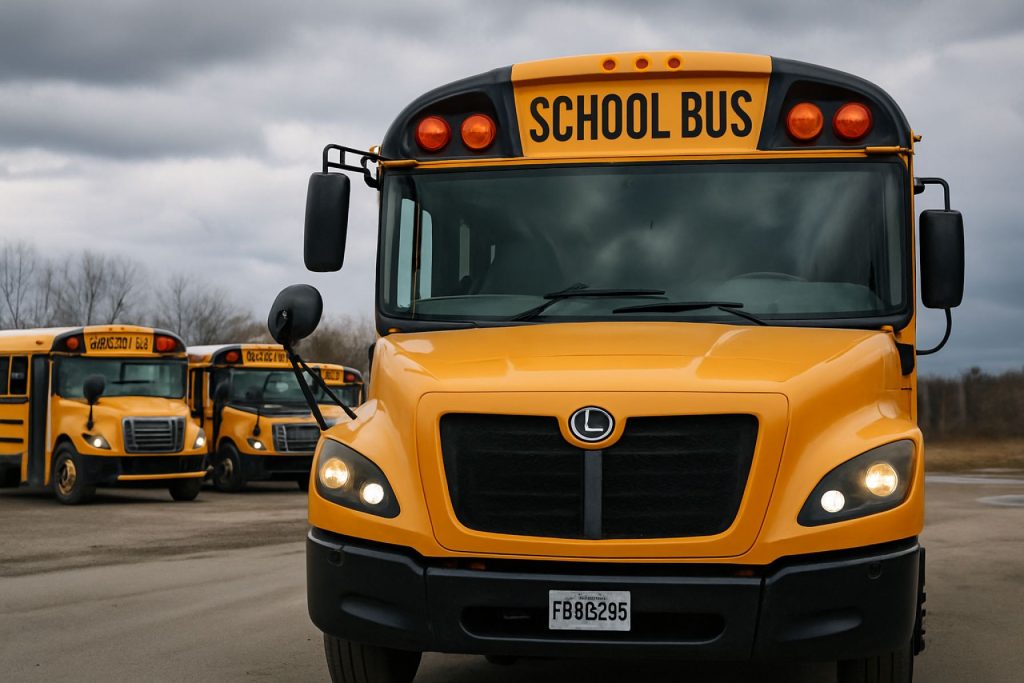
- Lion Electric faced major setbacks, including layoffs, debt, legal challenges, and stranded electric school buses.
- A new Quebec government subsidy now offers up to $240,000 per Lion-built electric school bus, surpassing previous support and boosting local competitiveness against U.S. rivals.
- This funding injection has revitalized investor and public confidence in Lion’s Canadian operations, though U.S. expansion remains at risk.
- Three out of four electric school buses in Quebec already use Lion Electric, highlighting the brand’s regional dominance.
- The company’s recovery underscores the critical role of public investment, local manufacturing, and strategic policymaking in supporting clean energy innovation.
- The outcome for Lion Electric may offer a pivotal blueprint—or a cautionary tale—for the future of electric vehicles in North America.
Thunderheads gathered over Lion Electric as layoffs, mounting debts, and legal heat cast long shadows across the Canadian company’s ambitious dream of electrifying North America’s school bus fleet. School districts found themselves staring at purchase orders turned to vapor, or at yellow buses stranded, batteries dead and answers lacking. For months, the future of Lion’s once-thriving operation hung in the balance – buffeted by Wall Street lawsuits and layoffs that swept hundreds of workers from factories in both Canada and the United States.
Yet, just as it seemed the company might slide into the ranks of cleantech casualties, a new lifeline appeared – courtesy of the Quebec government.
Suddenly, the provincial authorities unveiled a sweeping new subsidy for electric school buses, injecting fresh optimism, capital, and a vital sense of purpose into Lion’s beleaguered headquarters in Saint-Jérôme. The program, in an apparent ripple effect to counter proposed U.S. tariffs targeting Canadian-made electric vehicles, allows each new Lion-built school bus to qualify for up to $240,000 in incentive funding. That boost towers above the previous $175,000 and leaves U.S. rivals such as Blue Bird and Thomas Built likely outmatched on Quebec turf.
The impact is visceral. Nearly three of every four electric school buses on Quebec roads already carry Lion’s logo – a testament to the company’s homegrown dominance. For local investors like Vincent Chiara of Groupe MACH, and board member Pierre Wilkie, the government’s move reignited the faith to inject millions more into keeping Lion’s Canadian manufacturing alive, though not enough to rescue its shuttered Illinois factory.
While the specifics of the deal remain cloaked in financial discretion, the effect is clear: Lion now holds onto its Canadian roots, and a window has opened for the company to stabilize, retool, and perhaps restore its battered reputation. Unresolved lawsuits continue to swirl, and the fate of stranded buses remains uncertain. Nevertheless, a flicker of hope has returned.
For Canada’s clean energy sector, the lesson roars loud and clear: strategic policy, local manufacturing, and public investment can still breathe life into homegrown innovation — even when the headwinds of global competition and market skepticism blow strong.
As the world watches electric vehicles move from promise to mainstream necessity, Lion’s rebound in Quebec could prove to be a pivotal blueprint—or a cautionary tale. The success or failure of this latest gamble will echo far beyond provincial borders.
Ready to dive deeper into the future of clean transportation? Explore the latest advances at Lion Electric and stay current with clean energy developments at Bloomberg or The New York Times.
Quebec’s Electric School Bus Gamble: Hidden Truths, Fast Facts & Future Predictions for Lion Electric
Unpacking Lion Electric’s Resurgence: An In-Depth Look Beyond the Headlines
Lion Electric’s turbulent year captured headlines – but the story goes much deeper. As Canada’s ambition to lead the electrification of school transportation hangs in the balance, the company’s fate impacts not only future generations, but also the entire North American electric vehicle (EV) industry. Here’s what you need to know—and what the original reporting didn’t fully cover.
—
1. The Bigger Picture: Lion Electric’s Industry Influence
Market Share & Leadership
– As of early 2024, Lion Electric had more than 800 electric school buses on the road across North America, the largest fleet in Canada and a leader among U.S. competitors.
– Lion also produces electric trucks, catering to last-mile delivery fleets and municipal clients.
The Role of Government Subsidies
– Government policy is crucial to the EV ecosystem, as electric buses still cost roughly 3–4x more than diesel models without incentives.
– Quebec’s new subsidy (up to $240,000 per bus) not only leapfrogs past U.S. incentives, but also enables school districts to replace their fleets cost-neutrally when accounting for fuel and maintenance savings.
—
2. Industry Trends & Insider Insights
Electrification Mandates
– The Canadian government pledged that all new medium- and heavy-duty vehicle sales be zero-emission by 2040, intensifying pressure (Source: Transport Canada).
– Similar mandates in New York and California are accelerating electric school bus adoption in the U.S.
Growing Pains for Rivals
– U.S.-based Blue Bird and Thomas Built Buses have seen recent delays and backlogs due to battery shortages and regulatory challenges.
– Startups like Proterra—once a Lion rival—filed for bankruptcy in 2023, highlighting the fragility of the sector.
—
3. Key Features, Specs & Pricing
| Feature | Lion D Electric School Bus | Blue Bird Vision Electric | Thomas Built Jouley |
|———————–|—————————————-|——————————-|——————————|
| Passenger Capacity | Up to 77 | Up to 77 | Up to 81 |
| Range (per charge) | 155–250 km (96–155 miles) | Up to 120 miles | Up to 138 miles |
| Battery Type | Lithium-ion, 135–210 kWh options | 155 kWh | Proterra, 226 kWh |
| Price (pre-incentive) | ~$400,000–$450,000 | ~$400,000–$430,000 | ~$400,000–$425,000 |
Sources: Manufacturer data, Q1 2024.
—
4. Security, Sustainability & Limitations
– Battery Disposal: Lithium-ion batteries have a lifespan of 8–10 years. Recycling at scale remains a challenge, though companies like Li-Cycle are making progress.
– Grid Impact: Significant school fleet charging can strain local grids during peak hours—smart charging management is essential.
– Winter Performance: Cold Canadian winters reduce battery range by up to 30%. Operators need adaptive charging and heating strategies.
—
5. Pressing Questions Answered
Q: Will the Quebec subsidies result in lower costs for schools and taxpayers?
Yes. Combined with federal incentives and operational fuel savings, many school districts expect to break even within 5–8 years.
Q: Is Lion Electric profitable yet?
No. Despite the Quebec lifeline, Lion has yet to reach consistent profitability, like most early-stage EV manufacturers. (See: Q1 2024 earnings.)
Q: Are there risks for buyers?
Yes—delivery delays, warranty coverage amid lawsuits, and the company’s long-term financial health all require caution.
Q: Is this sustainable for the government?
Quebec’s investment aims to secure high-tech jobs long-term and establish the province as a North American EV hub, but critics warn of ballooning costs if global demand slows.
—
6. Real-World Use Cases & Life Hacks for Fleet Operators
How-To: Maximizing Electric School Bus ROI
1. Analyze route lengths and terrain to assign buses within optimal battery range.
2. Install level 2 fast chargers at depots and stagger charging to avoid peak grid rates.
3. Track and optimize total cost of ownership—including preventative battery care.
4. Use manufacturer telematics platforms (like LionBeat) to monitor real-time vehicle health.
Industry Trends:
– Major U.S. school districts (e.g., Los Angeles, NYC) piloting hundreds of electric buses. Market expected to triple by 2030, led by public funding and emissions mandates.
– Experts (e.g., BloombergNEF) project that by 2040, 70% of global bus sales will be electric.
—
7. Controversies & Limitations
– Cross-Border Issues: Proposed U.S. tariffs jeopardize Canadian imports, prompting Quebec’s aggressive counter-subsidies.
– Employment Impact: Lion’s Illinois plant remains shuttered, highlighting risks when government support is not coordinated.
– Legal Uncertainty: Ongoing investor lawsuits over missed deliveries could cloud Lion’s recovery.
—
8. Pros & Cons At A Glance
Pros
– Strong policy support and local manufacturing create jobs and regional expertise.
– Lower emissions and noise pollution benefit student health.
– Operating savings can recoup higher upfront costs.
Cons
– Financial instability and supply chain hiccups risk delivery delays.
– Battery recycling and winter performance remain challenges.
– Heavy reliance on government funding creates long-term risk if policies shift.
—
9. Actionable Recommendations & Quick Tips
For School Districts & Fleet Owners:
– Vet manufacturer track records and demand transparency on warranty/parts fulfillment.
– Evaluate total lifecycle costs with energy providers—apply for both provincial and federal incentives.
– Start with pilot programs to test winter performance and monitor vehicle telematics for optimization.
For Policymakers & Investors:
– Prioritize coordinated North American supply chains and recycling infrastructure.
– Support pilot hydrogen or solid-state battery tech to diversify future options.
—
10. Where To Learn More
– Explore Lion Electric’s innovations and solutions at the official Lion Electric site.
– Follow reliable business news and market analyses at Bloomberg and The New York Times.
—
Final Thought
Quebec’s bold investment in Lion Electric is both a beacon and a warning. The stakes—for jobs, tech leadership, and kids’ futures—could not be higher. Will smart policy and local innovation steer the company back to growth, or will unresolved risks prove too great? Watch closely; the answer could shape North America’s clean transportation future.
—
Keywords: Lion Electric, electric school bus, Quebec subsidies, EV market trends, school fleet electrification, clean energy investment, battery recycling, transportation policy, EV manufacturing, sustainability, North American EV industry



